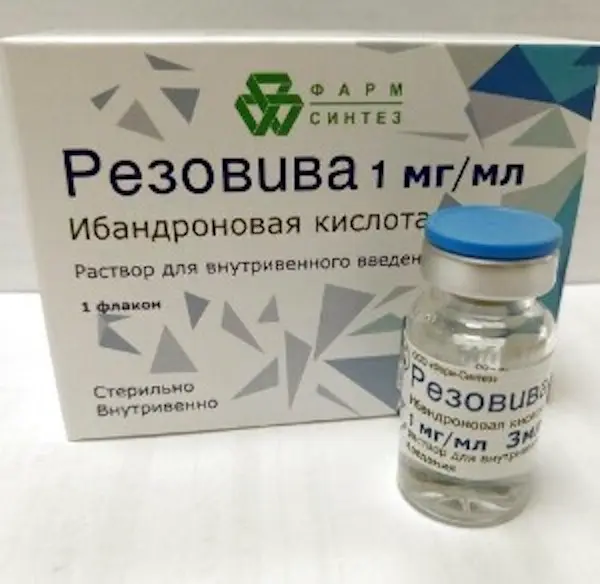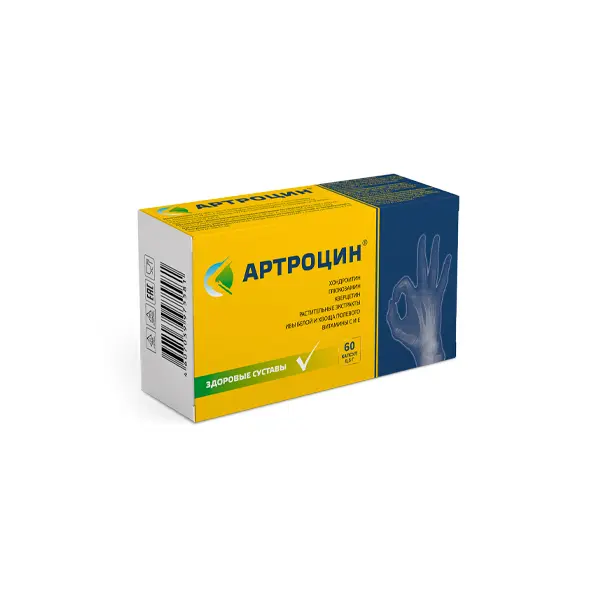Description
Rezoviva Pharmacodynamics
Ibandronic acid is a highly active nitrogen-containing bisphosphonate, an inhibitor of bone resorption and osteoclast activity. Ibandronic acid prevents bone destruction caused by blockade of glandular function, retinoids, tumors and tumor extracts in vivo.
Ibandronic acid does not impair bone mineralization when administered in therapeutic doses for the treatment of osteoporosis and does not affect the process of replenishing the pool of osteoclasts. The selective effect of ibandronic acid on bone tissue is due to its high affinity for hydroxyapatite, which constitutes the mineral matrix of bone.
Ibandronic acid dose-dependently inhibits bone resorption and has no direct effect on bone formation. In menopausal women, it reduces the increased rate of bone tissue renewal to the level of reproductive age, which leads to an overall progressive increase in bone mass, a decrease in bone collagen breakdown rates (concentration of deoxypyridinoline and cross-linked C- and N-telopeptides of type I collagen) in urine and serum, fracture frequency and an increase in bone mineral density (BMD).
The high activity and wide therapeutic range allow for flexible dosing and intermittent administration of the drug with a long period without treatment at relatively low doses.
Effectiveness
Bone mineral density (BMD)
Intravenous administration of ibandronic acid 3 mg once every 3 months for one year increases mean BMD of the femur, femoral neck, and trochanter by 2.4%, 2.3%, and 3.8%, respectively. Regardless of the duration of menopause and baseline bone mass loss, the use of ibandronic acid results in a significantly more pronounced change in BMD than placebo. A one-year treatment effect, defined as an increase in BMD, was observed in 92.1% of patients.
Biochemical markers of bone resorption
Clinically significant reductions in serum C-terminal procollagen type I peptide (CTX) were obtained after 3, 6, and 12 months of therapy. After one year of therapy with ibandronic acid at a dose of 3 mg intravenously, the decrease in CBC was 58.6% compared with the initial value.
Indications
Treatment of postmenopausal osteoporosis in women with an increased risk of fractures. The drug reduces the risk of vertebral fractures. No effect on the risk of femoral neck fractures has been established.
Contraindications
Hypersensitivity to ibandronic acid or other components of the drug.
Hypocalcemia. Hypocalcemia should be eliminated before starting RESOIVA as well as when prescribing all bisphosphonates used for treatment of osteoporosis.
Severe renal impairment (serum creatinine >200 µmol/L (2.3 mg/dL) or creatinine clearance <30 ml/min).
Pregnancy and breastfeeding.
Childhood (safety and efficacy in persons under 18 years of age has not been established).
Administration during pregnancy and breast feeding
Pregnancy
During preclinical studies, no direct embryotoxic or teratogenic effects were found. Adverse effects of ibandronic acid in reproductive toxicity studies in animals were the same as for all bisphosphonates – reduction in the number of embryos, disruption of childbirth, increased frequency of visceral abnormalities (syndrome of pulmonary-ureteric segment narrowing).
There is no experience in the clinical use of ibandronic acid in pregnant women.
Breastfeeding period
Excreted with milk in animals. In rats, ibandronate was present in milk from 2 to 24 h at concentrations of 8.1 to 0.4 ng/mL, after intravenous administration of ibandronate at a dose of 0.08 mg/kg. Concentrations in milk were on average 1.5 times higher than plasma concentrations. After 24 hours, the concentrations of ibandronic acid in plasma and milk were the same and corresponded to 5% of the maximum.
It is not known whether ibandronic acid penetrates into breast milk in humans. It is contraindicated during breast feeding.
Directions for use and dosages
- The drug is for intravenous use only!
- The drug is administered only by a specialist. Avoid intra-arterial administration or contact with surrounding tissues. Before administering, the solution should be inspected to make sure that there are no foreign impurities or discoloration. The bottle is intended for single use only.
- Standard dosage regimen
- 3 mg intravenously bolus (for 15-30 seconds) once every 3 months.
- The patient should additionally take calcium and vitamin D.
- If a scheduled injection is missed, an injection should be given as soon as possible. Further administration of the drug should be continued every 3 months after the last injection.
- The drug should not be administered more than once every 3 months.
- During the treatment, renal function and serum calcium, phosphorus and magnesium content should be monitored.
- Dosage in special groups of patients.
- Impaired liver function
- No dose adjustment is required (see section “Pharmacokinetics in special patient groups”).
- Renal dysfunction
- No dose adjustment is required in mild to moderately expressed renal dysfunction (creatinine clearance ? 30 ml/min). In creatinine clearance <30 mL/min, the decision to use the drug RESOIVA should be based on an individual assessment of the risk/benefit ratio for a particular patient (see section “Pharmacokinetics in special patient groups”).
- Older age.
- No dose adjustment is required.
- Children
- Safety and efficacy in persons under 18 years of age has not been established.





